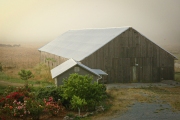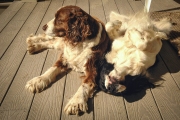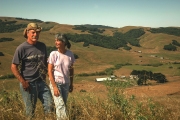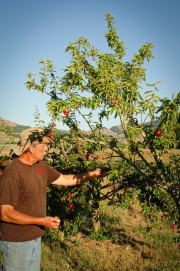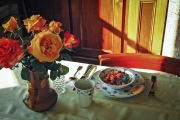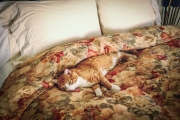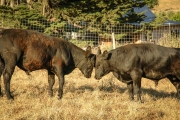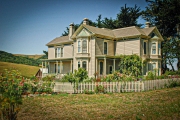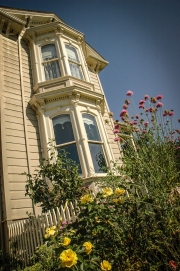writer | photographer
photo gallery
the story
There was a little something different about breakfast with Mike and Sally Gale at Chileno Valley Ranch. After spending a night in the house Sally’s great-great-grandfather built, my wife Charissa and I sat down for a breakfast he likely would have appreciated. What a spread—fresh fruit from vines in the backyard, fresh sausage, eggs from the neighbor’s chickens.
Then Sally brought out the toast. “I want to apologize,” says Sally. “We bought this bread at the store.”
As it turned out, it was the only thing we ate that wasn’t homemade. And it was the first time anyone had ever apologized to us for serving store-bought food.
It’s no surprise, though, when you consider how important home is to the Gales. Their 600-acre ranch in Marin County, California—in disarray and disrepair for decades—is now even more alive than it was when it was first purchased by Sally’s family in the 1862.
The house and grounds first belonged to Carlo Martinoiya, Sally’s great-grandfather. He built the house in the early 1860s, and his picture still hangs on the wall in an upstairs hall. The virgin redwood he used in the house made for a strong structure, and the land sustained a working dairy and cattle ranch for generations.
Though the land has been in Sally’s family all that time, caretakers didn’t always care for it the way family would have.
The house was vacated in the late 1980s, and stayed that way for seven years until Sally’s mother gave her the ranch. “She gave it to me to bring it back to life,” says Sally, a former pediatric social worker. She and Mike left their careers and returned to the family land, turning the house in to a bed and breakfast and the land into a working cattle ranch and a model of conservation and restoration.
The acreage surrounding the two-story Victorian home would be key to the Gales’ life on the land. But Sally and husband Mike—a self-proclaimed city boy who has learned his love for the land over time—started with making the house a home again.
“Sally was the general contractor, I was the laborer,” Mike says of the nearly five-year process of restoring the house to its 19th-century glory and beyond. Sally says, though, that she wasn’t in charge as much as the house itself was. “The house told me what to do,” she says. “And there was a lot of history to discover as we cleaned up.”
A great deal of that history got recycled during the restoration. The redwood siding on the front of the house was re-milled and used as flooring. The picket fence is built with wood salvaged during renovation. A two-story addition to the original house has a neighbor’s old staircase as its centerpiece, complete with ornate woodwork that looks remarkably similar to the main house’s original staircase. And the antique furniture throughout is all either family heirlooms or hand-picked from local antique dealers.
The Gales did as much of the work as they possibly could at every stage. Sally, an accomplished artist, drew renderings of how the house would eventually look. Mike used a huge magnet to collect old nails. They both tore out loads of old plaster—an experience they say they’ll never forget. “We wanted this house to be our house—our family’s house. We didn’t want to hire someone and use their ideas,” says Sally. “If there was something we could learn to do, we did.”
Mike, meanwhile, has learned to be a rancher. The Gales direct-market more than 70 head of grass-fed beef cattle each year. As Mike drives us around the ranch, moving cattle from pasture to pasture and cursing the occasional patch of milk thistle, he’s clear about how important the business is to their sustainable lifestyle.
“We’re not just selling steers, we’re selling the lifestyle of these animals,” he says. Those selling points include beef raised on native grasses with no hormones, no antibiotics and no shipping stress, and customers are willing to pay a premium for it.
A portion of Chileno Creek that runs through the property afforded yet another restoration project for the Gales, and they turned the local Marin Resource Conservation District for advice and financial help with the effort. A horse barn, milking barn and creamery that were little more than woodpiles have all been restored. The largest barn is a popular spot for weddings. The Gales also have an heirloom rose garden, an organic apple orchard and heritage-breed turkeys to occupy their time.
Sally says she and Mike are taking a break from the bed and breakfast business for now. She wants to focus on her art and grandchildren for a while, and Mike stays busy with Chileno Valley Beef and other ventures.
She assures me that they loved having visitors, and we have no reason to doubt that. An apology for store-bought bread underscores their hospitality, and their affection for all things home.
The toast, by the way, wasn’t all that bad. Quite delicious, in fact, with a smear of raspberry preserves on top. “The best I’ve ever had,” says my wife. Homemade, of course.
Down by the Creekbank. The Gales faced a massive restoration on the branch of Chileno Creek that runs through their property. But unlike the house, which was a huge out-of-pocket financial investment, they got help to turn the creek around.
The Gales had several goals for their piece of Chileno Creek:
- Fence livestock out
- Bring back habitats for steelhead and endangered salmon
- Reduce sediment loss
- Restore native vegetation
All of this was quite a tall order considering there were all of eight trees along the creek when they arrived at the ranch.
With grants from the California Coastal Conservancy, the Marin County Resource Conservation District and the state fish and game department, the Gales met their goals, and then some.
Mike already sees steelhead in the creek. They hope salmon—which once spawned in Chileno Creek—will return soon. Migratory songbirds are back in the trees along the bank.
And they have plenty of places to roost. Drip irrigation nursed more than 2,000 willow sprigs—along with 200 other native trees and shrubs—for three years. Volunteer willows filled in among what the Gales planted to form a dense canopy of native plants, where song sparrows, yellow warblers and ruby-crowned kinglets sing.
The Gales even added their own unique touch—a bridge made from the bottom of an old rail car that allows Mike to drive cattle across the creek instead of through it.


